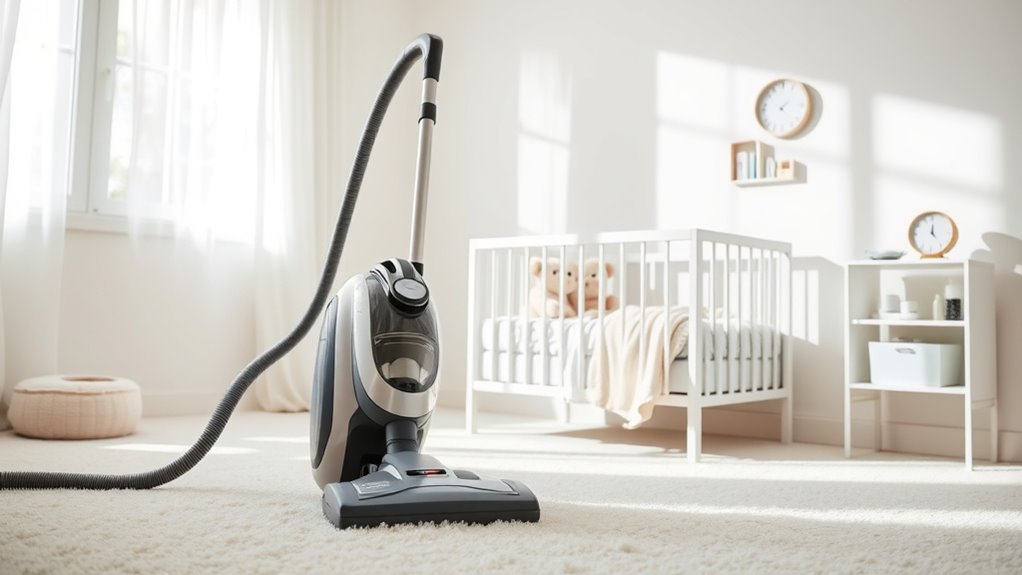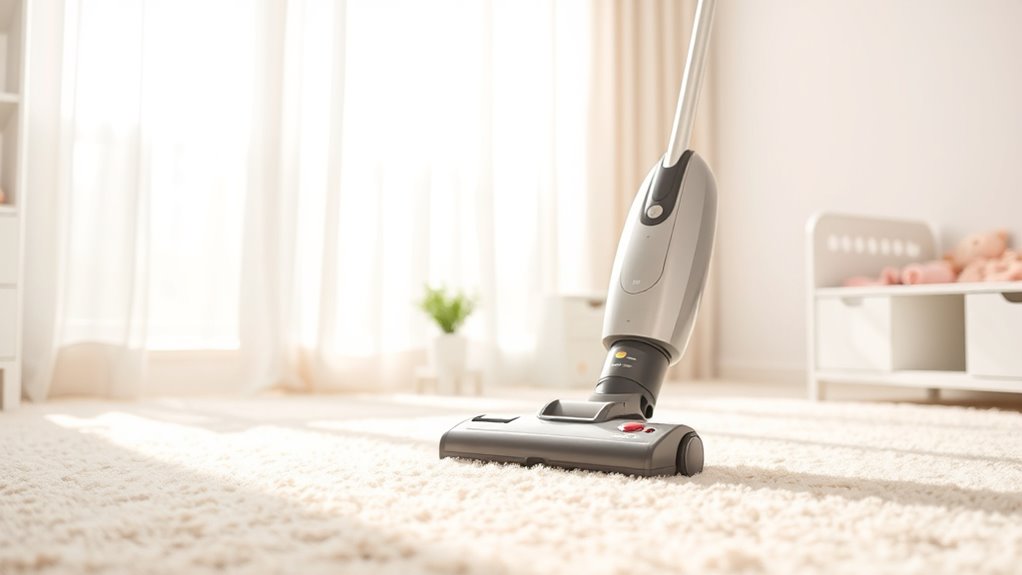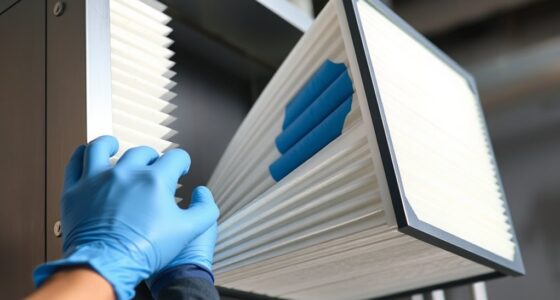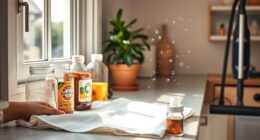To create an asthma-friendly nursery, choose a vacuum with HEPA filters, low noise, and lightweight design. Regularly maintain and replace filters every 3-6 months, and vacuum thoroughly in all areas, especially high-traffic zones. Use slow, overlapping strokes and avoid stirring up dust. Incorporate air purifiers, control humidity, and establish a consistent cleaning schedule. Keep staff well-trained on proper techniques for ideal allergen reduction—more tips await to help you improve your space.
Key Takeaways
- Vacuum slowly with overlapping strokes to effectively remove allergens without dispersing dust into the air.
- Use a vacuum with HEPA filters and antioxidant-rich filters to trap tiny particles and improve air quality.
- Empty the vacuum canister or replace bags regularly to maintain suction and prevent allergen buildup.
- Train staff on proper vacuuming techniques, emphasizing thoroughness in all areas, including under furniture and corners.
- Maintain a consistent vacuuming schedule of at least 2-3 times weekly to reduce allergen accumulation.
Choosing the Right Vacuum Cleaner for Sensitive Environments

To create a nursery that’s safe for a child with asthma, choosing the right vacuum cleaner is vital. Look for models designed to reduce allergy triggers, such as HEPA filter vacuums, which trap dust, pollen, and pet dander effectively. These filters help prevent airborne irritants from circulating in the room. Additionally, consider vacuum noise levels; quieter machines are less likely to startle or disturb your child, making cleaning less stressful for everyone. A vacuum with a low noise output also encourages regular cleaning, which is indispensable for maintaining an asthma-friendly environment. Prioritize lightweight, easy-to-maneuver vacuums that don’t compromise on filtration quality or noise suppression. Incorporating vacuums with antioxidant-rich filters can further improve indoor air quality by capturing additional harmful particles. Making an informed choice ensures your nursery stays clean and safe for your child’s sensitive respiratory health.
Regular Maintenance and Filter Replacement Procedures

You should set a regular schedule for changing filters to keep your nursery air clean. Following proper vacuuming routines guarantees dust and allergens are effectively removed. Consistent maintenance helps maintain a healthy environment for your little one. Incorporating air quality improvements such as upgrading your vacuum’s filtration system can further enhance indoor air purity.
Scheduled Filter Changes
Regularly scheduled filter changes are crucial for maintaining an asthma‑friendly nursery. Knowing your filter’s lifespan helps you plan timely replacements, preventing buildup of allergens and dust. Most filters have recommended replacement intervals, typically every 3 to 6 months, but this can vary based on usage and manufacturer guidelines. Ignoring these intervals can reduce filter effectiveness, allowing airborne irritants to circulate and compromise air quality. By adhering to your filter’s lifespan and replacement schedule, you ensure your vacuum operates at its best, removing allergens efficiently. Set reminders to check and change filters regularly, especially if the nursery sees frequent activity. Consistent filter maintenance is a simple yet essential step to create a healthier environment for children with asthma. Proper maintenance of your vacuum filter can significantly enhance indoor air quality and help reduce allergy symptoms.
Proper Vacuuming Schedule
Maintaining a proper vacuuming schedule is vital for keeping your nursery air clean and allergen-free. You should aim for regular vacuuming, ideally at least two to three times a week, to prevent dust and allergens from building up. Consistency is key, so establish a routine that fits your nursery’s activity level. Staff training is essential to ensure everyone understands the importance of correct vacuuming techniques and proper filter handling. Educate staff on how often to vacuum, how to operate the equipment safely, and when to replace filters to maintain peak performance. Additionally, using vacuum cleaners with HEPA filters can significantly improve allergen removal and air quality. By sticking to a reliable vacuuming frequency and investing in staff training, you’ll create a healthier environment that supports children with asthma and allergies.
Techniques for Effective Vacuuming in Nursery Settings

To guarantee effective vacuuming in nursery settings, it’s essential to use proper techniques that minimize allergen disturbance. Start by vacuuming slowly and methodically, ensuring you cover all areas thoroughly. Use a vacuum cleaner with a HEPA filter to trap pet hair and other allergens efficiently. When cleaning, move the vacuum in overlapping strokes, especially around corners and edges, to remove hidden debris. Avoid rushing, as quick passes can stir up allergens instead of capturing them. Focus on high-traffic zones and spots where pet hair tends to accumulate. Regularly empty the vacuum canister or replace the bag to maintain suction power. Incorporating automated cleaning tools with advanced AI-powered features can further enhance allergen removal and ensure thorough cleaning. These techniques help reduce pet hair and allergens, creating a safer, healthier environment for children with asthma.
Special Considerations for Carpeted vs. Hard Floor Surfaces

Since carpeted and hard floor surfaces require different cleaning approaches, understanding these distinctions is essential for effective vacuuming in nursery rooms. For carpet maintenance, use a vacuum with a HEPA filter and strong suction to remove dust, allergens, and debris embedded in fibers. Regular deep cleaning helps reduce asthma triggers and maintains a healthy environment. When caring for hard floors, choose a vacuum with adjustable settings or a soft brush attachment to prevent scratching. Hard floor care involves frequent sweeping or dust mopping to remove surface dust, complemented by vacuuming to pick up fine particles. Additionally, selecting an air purifier with HEPA filtration can further improve air quality by capturing airborne allergens and pollutants. By tailoring your cleaning methods to each surface, you guarantee thorough removal of allergens while preserving the integrity of carpets and hard floors alike. This targeted approach promotes a healthier nursery environment for children with asthma.
Minimizing Dust During and After Vacuuming

Minimizing dust during and after vacuuming is essential for creating a safe, asthma-friendly nursery. To reduce airborne particles, use a vacuum with a HEPA filter and vacuum slowly, allowing the filter to trap allergens effectively. Managing pet allergies involves vacuuming regularly to prevent pet dander buildup, which can worsen asthma symptoms. To keep noise levels low, choose quieter models or vacuum during times when noise is less disruptive, reducing stress for sensitive children. Consider the following tips:
| Tip | Benefit | Implementation |
|---|---|---|
| Use HEPA filters | Traps airborne allergens | Regularly replace or clean filters |
| Vacuum slowly | Minimizes dust escape | Move methodically across surfaces |
| Manage pet dander | Reduces allergy triggers | Vacuum pet areas frequently |
| Noise reduction techniques | Less stress for kids | Opt for quieter vacuums or vacuum at quieter times |
| Post-vacuum air cleaning | Clears remaining dust | Use air purifiers after vacuuming |
A proper vacuuming technique can further improve air quality and reduce allergen circulation in the nursery.
Incorporating Additional Air Purification Methods

To improve air quality further, consider choosing an air purifier with a HEPA filter specifically designed for allergy and asthma relief. You should also manage humidity levels and guarantee proper ventilation to reduce airborne irritants. These strategies work together to create a safer, more comfortable nursery environment. Incorporating seasonal variations in your cleaning habits can also help address different allergen levels throughout the year.
Air Purifier Selection
Choosing the right air purifier is essential for creating a healthier nursery environment, especially when aiming to reduce asthma triggers. Look for models equipped with HEPA filters, which efficiently trap airborne allergens like dust mites, pet dander, and pollen. Make certain the purifier supports adequate air exchange to keep the air fresh and minimize pollutant buildup. When selecting an air purifier, consider these factors:
- Filtration efficiency: Prioritize HEPA filters for maximum allergen removal.
- Room size compatibility: Match the purifier’s capacity to the nursery’s square footage.
- Noise level: Choose quiet models to avoid disrupting sleep or playtime.
Humidity Control Techniques
Maintaining proper humidity levels in the nursery is essential for reducing asthma triggers and supporting overall air quality. You should aim to keep air humidity between 30-50%, as too much moisture encourages mold growth, which can worsen asthma symptoms. Use a hygrometer to monitor humidity regularly, adjusting with a humidifier or dehumidifier as needed. When the air is too dry, a humidifier adds moisture, preventing dry air that irritates airways. Conversely, dehumidifiers remove excess moisture, helping prevent mold development. Good air humidity control not only minimizes mold risks but also creates a more comfortable environment for the child. Regularly calibrating your monitoring devices ensures accurate readings and effective humidity management. Consistent monitoring and adjusting are key to maintaining a healthy, asthma-friendly nursery room.
Ventilation Optimization
Optimizing ventilation in the nursery is essential for reducing airborne asthma triggers and guaranteeing better air quality. You can improve air exchange by using ventilation fans to circulate fresh air and remove pollutants. Consider adding air purifiers with HEPA filters to further clean the air, reducing dust and allergens. Keep windows open when weather permits to promote natural airflow, but ensure it’s safe and consistent. Regularly check and maintain ventilation fans to ensure they operate effectively. To maximize benefits, combine these methods with proper vacuuming practices. You’ll create a healthier environment for children with asthma by enhancing airflow and reducing airborne irritants. Additionally, understanding the importance of air quality, such as avoiding pollutants and allergens, is crucial in maintaining a safe nursery environment.
Establishing a Consistent Cleaning Schedule

To effectively reduce allergens and create a safe environment for your baby, establishing a consistent cleaning schedule is essential. A reliable vacuuming schedule guarantees you regularly remove dust, pet dander, and other irritants that can trigger asthma. Consistency in cleaning helps prevent the buildup of allergens, making the nursery safer over time. Decide on specific days and times to vacuum, and stick to that routine. This not only maintains a cleaner space but also helps you monitor the effectiveness of your cleaning efforts. Remember, a well-planned cleaning schedule minimizes airborne particles and supports your goal of an asthma-friendly nursery. Staying consistent with vacuuming reinforces a healthier environment for your little one.
Training Staff and Caregivers on Proper Vacuuming Practices

Training staff and caregivers on proper vacuuming practices is essential to guarantee consistent removal of allergens from the nursery. Proper technique ensures dust mites and other allergens are effectively reduced, creating a safer environment for children with asthma. To achieve this, focus on:
- Using HEPA-filter vacuums to trap tiny particles and prevent allergen dispersal
- Vacuuming thoroughly in all areas, including under furniture and in corners
- Regularly replacing vacuum bags or cleaning filters to maintain suction power
Educate staff on the importance of slow, deliberate passes over surfaces to maximize allergen removal. Emphasize that consistent, correct vacuuming helps minimize dust mite populations, reducing triggers and promoting healthier indoor air quality. Proper training guarantees everyone contributes to allergen reduction efforts.
Frequently Asked Questions
How Do I Choose Vacuum Attachments Suitable for Infant-Safe Cleaning?
When choosing vacuum attachments for infant-safe cleaning, you should prioritize compatibility with your vacuum and guarantee they’re designed for sensitive environments. Look for attachments that are compatible with your vacuum model and are labeled as gentle or suitable for delicate surfaces. Opt for infant-safe cleaning tools that effectively trap dust and allergens without releasing particles back into the air. This way, you create a healthier nursery environment while keeping cleaning simple and safe.
Can Vacuuming Disrupt a Sleeping Baby or Disturb Nursery Routines?
Vacuuming can disrupt a sleeping baby or nursery routines if noise levels are too high or if you don’t consider timing. To avoid disturbance, choose a vacuum with quiet operation and vacuum during nap times or when the baby is out of the room. This way, you minimize noise and maintain a calm environment, ensuring your baby sleeps peacefully and routines stay consistent.
What Are the Signs Indicating a Vacuum Needs Repair or Replacement?
You’ll notice your vacuum needs repair or replacement if you experience consistent vacuum suction issues, making cleaning less effective. Additionally, a decline in filter performance can cause decreased airflow and poor filtration, indicating it’s time for maintenance or a new vacuum. If you hear unusual noises or notice reduced cleaning power, don’t delay—address these signs promptly to guarantee peak performance and maintain a healthy, asthma-friendly nursery environment.
Are There Specific Vacuum Features Recommended for Allergy Prevention?
Did you know HEPA filters can trap 99.97% of airborne particles? For allergy prevention, choose a vacuum with HEPA filters and a sealed system. These features prevent allergens from escaping back into the air, ensuring a cleaner environment. Using such vacuums helps reduce asthma triggers, especially in nursery rooms. Prioritize models that are specifically designed for allergy sufferers, making your space safer and healthier for little ones.
How Can I Ensure Proper Storage of Cleaning Equipment in Nurseries?
To guarantee proper storage of cleaning equipment in nurseries, you should focus on effective storage organization. Keep cleaning supplies in a designated, secure area away from children, ideally in a locked cabinet. Use labeled, airtight containers for chemicals, and store equipment like mops and vacuums upright to prevent spills and damage. Regularly check for leaks or expired products, and maintain a tidy, accessible space to promote safety and cleanliness.
Conclusion
By following these vacuuming tips, you create a nursery environment as clean as a whistle—safe and healthy for little lungs. Regular maintenance, proper techniques, and staff training guarantee dust and allergens stay at bay. Think of your cleaning routine as a gentle breeze that refreshes the space, making it a cozy haven for your child. Stay consistent, stay vigilant, and watch your nursery become a sanctuary free from asthma triggers.










